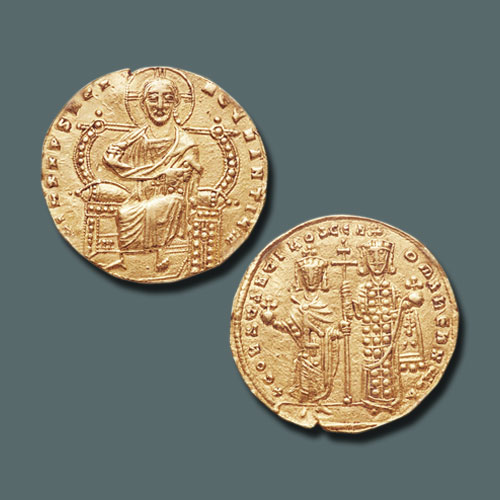Constantine VII becomes nominal ruler of the Byzantine Empire
2019-06-06 Thu
Constantine VII Porphyrogenitus was the fourth Emperor of the Macedonian dynasty of the Byzantine Empire, reigning from 913 to 959. He was the son of the emperor Leo VI and his fourth wife, Zoe. Today on this day in 913, Constantine VII becomes nominal ruler of the Byzantine Empire, under the regency of a seven-man council headed by Patriarch Nicholas Mystikos, appointed by his uncle Alexander III on his deathbed. During his reign gold, silver, and copper issued from Constantinople and Cherson mint. Depicted here is a gold Solidus Issued under his reign from Constantinople mint. The obverse of a coin depicts the full-length figure of Christ, seated on a throne with a curved back, wearing nimbus cruciger, pallium, and colobium, right hand raised in benediction, a book of Gospels in left. On the other hand, the reverse of a coin has crowned standing figures of Constantine VII (on right), bearded, wearing loros with cross on sleeve, and Romanus II (shorter, on left), wearing chlamys with cross on front, both on rectangular dais, each holding globus cruciger in outer hand and jointly holding long patriarchal cross with globular terminus between them. Image Source: Heritage AuctionsLatest News
-
Malwa Sultan Mahmud Shah Silver Coins
2025-09-11 ThuMalwa Sultan Mahmud Shah minted silver coins in round and square flans. <br><br> For round coins,...
-
Malwa Sultan Mahmud Shah Billon coin
2025-08-26 TueMalwa Sultan Mahmud Shah's billon coins followed three weight standards: 100 rati, 96 rati, and 80 r...
-
Fascinating Archaeological Facts on Postage Stamps - 91
2025-08-23 SatRhinoceros is one of the oldest land mammal species existing in India. There are five species of rhi...
-
Fascinating Archaeological Facts on Postage Stamps - 90
2025-08-23 SatUthiramerur, a Village in Kanchipuram, Tamil Nadu, is notable for its Temple inscriptions that descr...
-
Fascinating Archaeological Facts on Postage Stamps - 89
2025-08-21 ThuThe term “millet” is derived from the Latin word “milum,” which translates to grain. millets...

